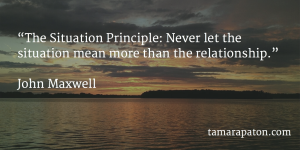

Most of my workdays are spent solo. I’m a lone ranger either working from my home office or nursing a cold coffee at my local Starbucks.
There are special days and occasions, however, when I simply can’t be alone. In January, I attended the Women’s March in Washington DC, bearing witness to the stories of friends I hadn’t yet met. And on International Women’s Day, I joined hundreds of business leaders at a #GoSponsorHer event in Toronto.
#GoSponsorHer is a movement that encourages executives to sponsor a high-potential woman in their networks. The idea is to meet for coffee, snap a selfie, and use social media to challenge a few other executives to do the same.
The event I attended opened with the difference between sponsorship and mentorship. According to panel moderator John Stackhouse, SVP with Royal Bank of Canada, “Coaches talk to you. Mentors talk with you. Sponsors talk to, with and about you.”
In addition, sponsors create opportunities for their protégées, in part because doing so creates a rising tide that lifts all boats:
“Sponsors may advise or steer you but their chief role is to develop you as a leader. Why? Not so much from like-mindedness or altruism, but because furthering your career helps further their career, organization or vision. Where a mentor might help you envision your next position, a sponsor will advocate for your promotion and lever open the door.”
#GoSponsorHer got me thinking about the support I’ve enjoyed in the past and the role I play for others today. During my early days in capital markets, a more seasoned colleague always made a space for me on her deal teams. She spoke up for me at key promotion windows and supported my application to business schools. In contrast, only 13% of high-level female executives on Wall Street have a sponsor. I had no idea how fortunate I was at the time.
Today, one of my board chairs extends the same support. He identified a leadership role I might play in a year or two and suggested a development path to prepare me. When the time came and I wondered whether I was ready, he talked me out of my own insecurity. I wouldn’t serve as a committee chair or board vice chair without him.
Admittedly, these sponsors found and chose me. In between, I spent years wandering a less than strategic career path. And I never thought to seek a sponsor to help steer and accelerate my trajectory. I thought doing good work and making my boss happy would be enough.
According to the #GoSponsorHer campaign, I am not alone. Women have more than enough mentors but are only half as likely as their male peers to have a sponsor. Women comprise almost half of Canada’s workforce and more than half of all university graduates, yet they hold less than one-third of senior management positions, and fewer than 5% of CEO positions. The outcomes are even more disheartening for visible minorities, with women of colour comprising 20% of the population, but holding only one of the CEO roles in the S&P 500.
Sponsorship is even more important as we build board careers. Most organizations don’t publicly advertise new director roles, instead relying on their professional networks and executive search firms to surface candidates. On our own, we need to be a little scrappy and renegade in our approach to a board career. A sponsor’s help, however, can land an aspiring director on a board’s radar screen more easily and graciously than she would under her own power.
Of course, wanting a sponsor is a first step, but insufficient on its own. To advance our board careers, we must pursue sponsors actively and help others do the same.
Position yourself
First, consider your readiness for sponsorship.The strongest protégés rise to the occasion by performing well and demonstrating loyalty. This online assessment from HBR highlights the more specific capabilities that a protégé should bring to the table.
Sylvia Ann Hewlett, the CEO of the Center for Talent Innovation, recommends raising your profile in a number of settings. To gain exposure to powerful individuals outside your team, department or division, make yourself visible outside your official job description. Volunteer for formal mentoring and seek opportunities with high-potential leadership development programs inside your organization. Spearhead a philanthropic project, plan a company-wide event or consider taking a leading role in an employee network.
Seek out support
Mark Wiseman, a senior executive at BlackRock and a founding sponsor with #GoSponsorHer, encourages young leaders to “look for someone you genuinely like and wish to emulate.” In light of the time your sponsor will spend with you and working on your behalf, it only makes sense to look to those with whom you have common ground.
In a large organization, Hewlett recommends scanning your organization for a sponsor that is two levels above you. In smaller organizations, look to the founder, president or those who are part of his or her inner circle.
Once we have our eye on the right area of the org chart, we need to take our analysis a step further. Hewlett’s research suggests that the traits that female talent values and seeks in a sponsor aren’t generally held by those with real power in the organization. Instead, your ideal sponsor may lead in a way you don’t care to copy. But it’s their clout and their contacts, not necessarily their style, that will accelerate your career.
Build your own board of directors
The first sponsor relationship is just the beginning . The Centre for Talent Innovation suggests that the ideal career life raft consists of three sponsors. In organizations with fewer than ten people, you’re best served by having one sponsor within the firm and two outside of it in the same industry. In larger firms, you’ll want one outsider and two insiders — one in your line of sight and one in a different department or division.
You’ll sustain this resource by staying in touch with your sponsors. #GoSponsorHer co-founder Laura McGee aims for a monthly update via e-mail and some form of in-person contact every quarter. It’s important to give a sponsor updated insight into your performance, so they can share fresh stories and create opportunities at the right time.
Initiate a sponsorship program
Next, consider creating a sponsorship program for others. Mark Wiseman supports #GoSponsorHer because “Sponsor relationships happen more easily between men. Sponsorship programs are important to catalyze relationships that may not happen naturally.”
We can also support one another’s desire for sponsorship less formally. A leader at Merrill Lynch once met regularly with three other women, all high-potential leaders in different divisions of the firm. They updated one another on their projects and accomplishments and then talked each other up to more senior leaders. Their mutual support was effective, ultimately landing sponsors for all four women and promotions in short order.
Pay it forward
To enjoy the benefits of sponsorship from all sides, become a sponsor yourself. Look for leaders a few levels below you in your organization or industry. Rather than choosing your mini-me, be on the lookout for high-potential individuals who fill in a gap in your own experience. Choosing to support someone who is decidedly different from you will broaden your perspective and reduce your odds of being blindsided by trends or office politics.
It is possible for directors to sponsor executives who report to their boards, depending on the circumstances. Admittedly, a sponsorship relationship could disrupt the dynamics between the board and management. A CEO may hesitate to discipline a direct report, for example, if the poor performer has a board member’s ear. There is also a risk of sensitive information reaching a director without the CEO’s knowledge. As a result, CEOs must genuinely support the relationship developing between a sponsoring director and an executive. Alternatively, directors always have the option of sponsoring leaders in other industries or even within the competition.
Building — and being a part of — a posse of protégés is one of the smartest things a leader can do. Those who sponsor actively have an A-team at the ready. Protéges earn lifelong loyalty by serving when a crisis looms, a deadline threatens, or a massive opportunity knocks. Regardless of which role you play, sponsor relationships can slingshot careers forward.
Thank you for reading! If you found this post useful, please share it with others in your network. Doing so helps my work reach others and would mean so much to me.








